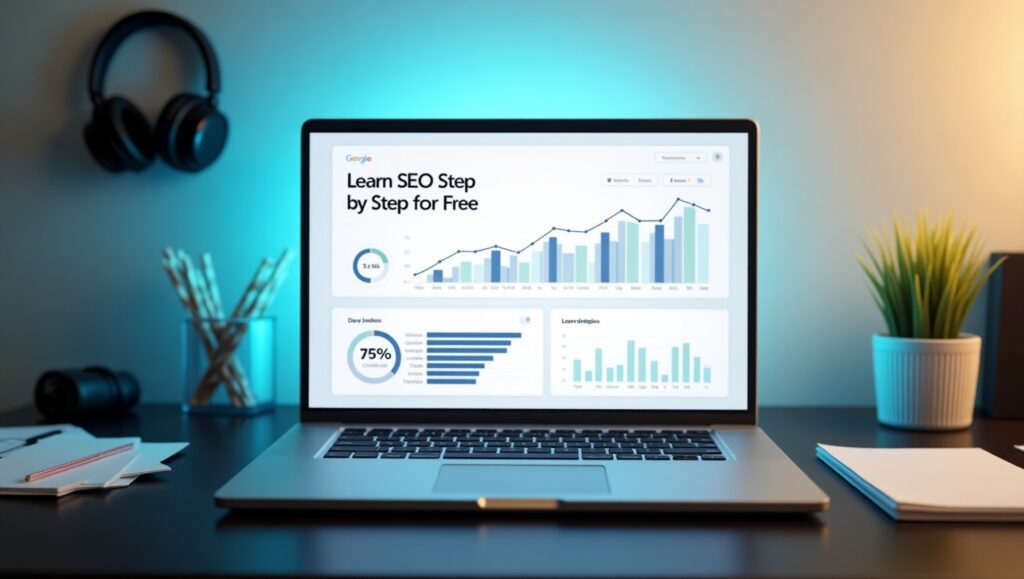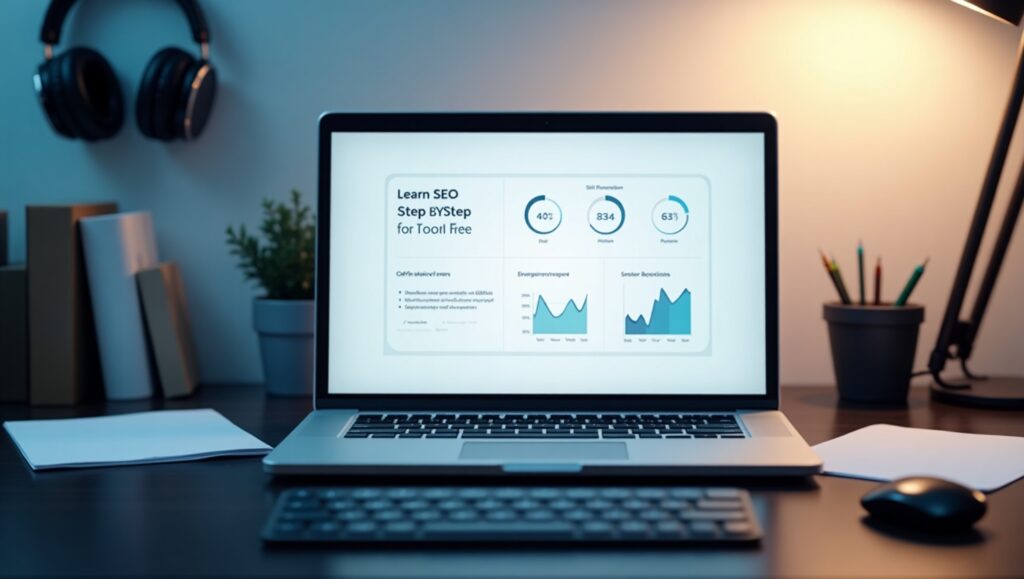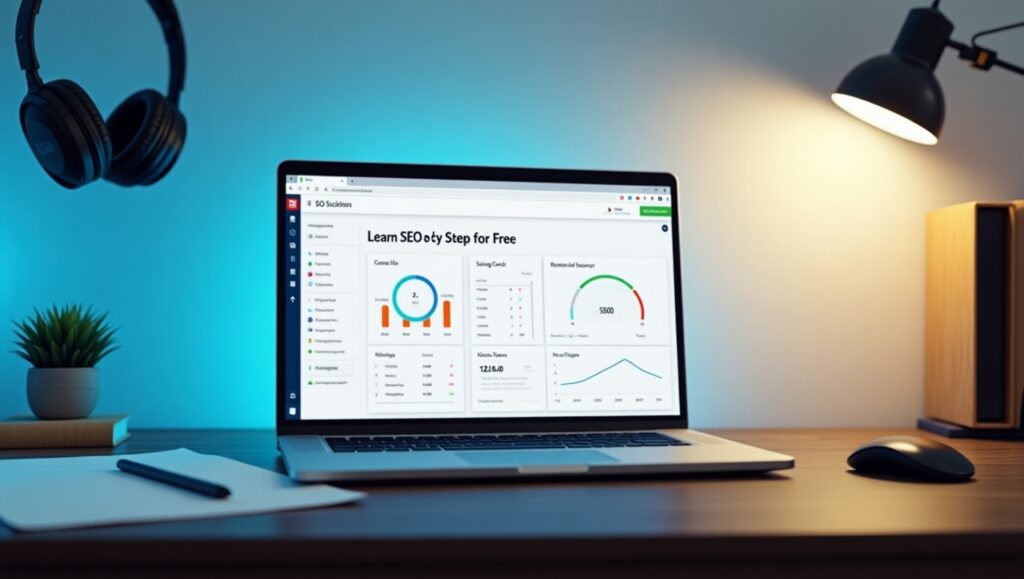
How to Learn SEO Step by Step for Free – [2025]
Are you struggling to get your website noticed in the ever-evolving digital landscape of 2025? You’re not alone. With search algorithms becoming increasingly sophisticated and competition fiercer than ever, mastering SEO can feel like trying to hit a moving target—especially when you’re on a tight budget. The good news? You don’t need expensive courses or fancy tools to climb the search engine rankings.
The secret to SEO success lies in understanding the fundamentals and implementing them strategically. Whether you’re a small business owner, a content creator, or simply someone looking to increase their online visibility, this comprehensive guide will walk you through everything you need to know—from keyword research techniques using free tools like QuestionDB and Google Keyword Planner, to decoding search intent, creating superior content that outshines competitors, and building quality backlinks without spending a dime.
💡 By the end of this guide, you’ll have a clear roadmap for implementing effective SEO strategies that can dramatically improve your website’s performance in 2025’s competitive search landscape and You will learnSEOstepbystepforfree.
Understanding the SEO Landscape in 2025
Learn SEO Step by Step for Free
Why SEO remains critical for online visibility
In 2025, SEO continues to be the cornerstone of digital visibility despite evolving significantly with AI advancements. The introduction of AI Overviews has transformed search results pages, pushing organic listings lower and decreasing click-through rates as Google aims to keep users on its platform.
However, this shift makes SEO more crucial than ever, as businesses must now optimize content to be AI-friendly while maintaining authenticity. The NEEAT framework (Notability, Experience, Expertise, Authoritativeness, and Trustworthiness) has replaced E-E-A-T, emphasizing the importance of demonstrating genuine expertise in your content to build trust with both users and search engines.
Analyzing your current rankings, traffic, and competitors
Before implementing any SEO strategy in 2025, it’s essential to conduct a comprehensive analysis of your current digital presence. Begin by evaluating your rankings for key terms and assessing your organic traffic patterns using analytics tools. Pay particular attention to user behavior signals, which have become increasingly influential in Google’s ranking decisions. Analyze engagement metrics like time on page, bounce rate, and conversion rates as these now significantly impact your visibility. When examining competitors, look beyond traditional websites to platforms fostering user-generated content like Reddit and Quora, which are gaining prominence as users seek authentic information over AI-generated content.
Identifying common SEO issues that hinder growth
Several critical SEO challenges can impede your growth in 2025’s digital landscape.
First, insufficient optimization for AI Overviews may result in decreased visibility as your content fails to provide concise, extractable information.
Second, neglecting the NEEAT framework by not prominently featuring author credentials and expertise signals can diminish trust with search engines.
Third, poor technical performance, particularly related to Core Web Vitals, continues to negatively impact rankings as Google refines how user experience affects search positions.
Fourth, inadequate content organization through topic clusters makes it difficult for search engines to understand your site’s relevance and authority in specific areas.
Finally, overlooking the shift toward privacy-first strategies in a post-third-party cookie world limits your ability to leverage valuable first-party data for personalization.
Now that we’ve established a solid understanding of the current SEO landscape, let’s explore how you can master keyword research without spending a dime in our next section, “Mastering Keyword Research for Free.”
Mastering Keyword Research for Free

Learn SEO Step by Step for Free
Mastering Keyword Research for Free
Now that we understand the evolving SEO landscape of 2025, it’s time to explore how to identify the right keywords without spending a dime. Effective keyword research remains the foundation of any successful SEO strategy, helping you connect with your target audience precisely when they’re searching for solutions you offer.
Generating a Comprehensive List of Keyword Ideas
The first step in mastering keyword research is creating an extensive list of potential keywords relevant to your niche. Start by brainstorming terms your target audience might use when searching for your products or services. Consider:
- Core topics related to your business
- Questions your customers frequently ask
- Problems your products or services solve
- Industry-specific terminology
- Seasonal trends or timely topics
Once you have a foundation of seed keywords, expand this list by examining your competitors’ content. Look at what terms they’re ranking for and identify gaps you could potentially fill. Remember, the goal isn’t just to find any keywords, but to discover terms that align with your business objectives and user intent.
Using Free Tools Like QuestionDB, Answer The Public, and Google Keyword Planner
In 2025, several powerful free tools remain essential for comprehensive keyword research:
Google Keyword Planner: Despite being primarily designed for advertisers, this tool provides valuable keyword ideas and approximate search volume data. While it may offer less precise metrics than paid alternatives, it remains a robust starting point for beginners.
AnswerThePublic: This visualization tool generates question-based keywords using autocomplete data from search engines. The free plan offers limited searches but provides excellent insight into how people phrase questions around your topics.
QuestionDB: Specializing in question-related keywords, this tool pulls data from multiple sources to help you identify exactly what information users are seeking. The free version provides enough functionality to discover valuable question-based keywords.
Google Trends: Perfect for identifying seasonal patterns and rising search terms, Google Trends helps you understand when certain keywords gain popularity, allowing you to plan content strategically.
Google Search Console: While this requires your site to already have some traffic, it’s invaluable for discovering “hidden” keyword opportunities where your content already ranks but could be optimized further.
Soovle: This free tool compiles autocomplete suggestions from various search engines simultaneously, giving you a broader perspective on potential keywords across different platforms.
Prioritizing Keywords Based on Difficulty, Commercial Intent, and Search Volume

Not all keywords are created equal. After generating your comprehensive list, you need to prioritize them based on three critical factors:
- Search Volume: This indicates how many people search for a term monthly. While higher volumes suggest greater traffic potential, they often come with increased competition.
- Keyword Difficulty: This measures how challenging it will be to rank for a particular term. As a beginner using free tools, focus on lower-difficulty keywords that present realistic ranking opportunities.
- Commercial Intent: Some keywords indicate users ready to purchase, while others suggest people seeking information. Balance your strategy with keywords across the buyer’s journey.
Free tools provide enough data to make informed decisions. Google Keyword Planner offers search volume ranges, while examining the current top-ranking pages for a keyword can give you a sense of difficulty—if you see major brands dominating the results, the competition is likely steep.
Identifying High-Value and Untapped Keyword Opportunities
The most valuable keywords often lie in unexpected places. Here are strategies to uncover these hidden gems:
- Long-tail keywords: These longer, more specific phrases typically have lower competition while attracting highly targeted traffic. They’re perfect for newcomers to SEO.
- Question-based keywords: Using tools like QuestionDB and AnswerThePublic, identify questions your audience is asking that competitors haven’t thoroughly addressed.
- Trending topics: Monitor Google Trends to spot emerging interests in your industry before they become highly competitive.
- Feature-specific terms: Instead of targeting broad product categories, focus on specific features or use cases that matter to your audience.
- Geographic variations: If relevant to your business, include location-based modifiers to target specific markets with less competition.
With your keywords properly researched and prioritized, you’re now positioned to move to the next critical step in your SEO journey. Understanding search intent will help you create content that truly satisfies user needs, converting your keyword research into content that ranks and converts. In the next section, “Decoding Search Intent for Better Content Creation,” we’ll explore how to align your content perfectly with what searchers are truly looking for.
Decoding Search Intent for Better Content Creation

Learn SEO Step by Step for Free
Decoding Search Intent for Better Content Creation
Now that we’ve mastered keyword research, let’s dive into search intent—the driving force behind every search query. Understanding why people search is just as important as knowing what they search for.
Understanding the Four Types of Search Intent
Search intent, also known as user intent, refers to the primary goal a user has when entering a query into a search engine. There are four main types you need to understand:
- Informational Intent: Users seeking information or answers to questions. Examples include “how does SEO work” or “what is technical SEO.”
- Commercial Intent: Users researching products or services before making a purchase decision. Examples include “best SEO tools 2025” or “SEO courses comparison.”
- Navigational Intent: Users looking for a specific website or page. Examples include “Ahrefs login” or “Google Search Console.”
- Transactional Intent: Users ready to complete an action or purchase. Examples include “buy SEO software” or “sign up for SEO course.”
Understanding these distinctions is crucial because each type requires different content approaches to satisfy user expectations. By aligning your content with the correct intent, you significantly increase your chances of ranking well in search results.
Aligning Your Content with User Expectations
Once you identify the search intent behind your target keywords, you need to structure your content accordingly:
- Content Type: Determine whether users expect a blog post, product page, tool, or video. For example, searches for “backlink checker” typically yield tools rather than articles, indicating a transactional intent.
- Content Format: Identify the preferred format for your content topic. For instance, “best air fryer” searches often return list posts because users want to compare multiple options, not read about a single product.
- Content Angle: Consider the unique perspective users are seeking. Including the current year (e.g., “best SEO tools 2025”) signals recency and relevance—a crucial factor for many searchers.
To satisfy user intent effectively:
- Limit intrusive pop-ups that hamper user experience
- Use readable fonts and incorporate subheadings for scanability
- Include multimedia elements like images and videos
- Ensure your content thoroughly addresses the user’s primary question or need
Analyzing Top-Ranking Pages to Understand What Google Values
Google’s search results provide a wealth of information about what content satisfies particular search intents. By studying the top-ranking pages for your target keywords, you can:
- Identify Content Patterns: Analyze what type of content consistently ranks (guides, lists, tools, etc.)
- Conduct Content Gap Analysis: Look for subtopics or questions covered by multiple top-ranking pages that your content might be missing
- Monitor Search Volatility: Keywords with low volatility in search results indicate stable user intent, making them more reliable targets for your content strategy
- Use SEO Tools: Leverage tools like Ahrefs’ AI Content Helper to automatically identify key topics based on current high-ranking content
Remember that Google prioritizes content that best meets user needs—this is evident in their Quality Rater Guidelines and reinforced by numerous case studies showing ranking improvements when content aligns with search intent.
With this solid understanding of search intent, we’re now ready to move on to the next crucial step in our free SEO journey: Creating Superior Content That Outranks Competitors—where we’ll explore specific techniques to develop content that satisfies both users and search engines.
Creating Superior Content That Outranks Competitors

Learn SEO step by step for free
Creating Superior Content That Outranks Competitors
Now that we’ve decoded search intent, let’s focus on creating content that actually outperforms your competition. With Google’s increased emphasis on E-E-A-T principles (Experience, Expertise, Authoritativeness, and Trustworthiness) in 2025, quality content has become more crucial than ever for ranking success.
Developing comprehensive content that covers topics thoroughly
The path to higher rankings begins with creating comprehensive content. In 2025’s competitive landscape, surface-level articles simply won’t cut it. Your content needs to thoroughly address every aspect of a topic that your audience might be interested in.
To develop truly comprehensive content:
- Begin with a detailed outline covering all potential questions and subtopics
- Research competitor content to identify gaps you can fill
- Include data, statistics, and examples to support your points
- Incorporate different content formats (text, images, videos) to enhance engagement
- Address the topic from multiple angles to satisfy different search intents
- Update content regularly with fresh information to maintain relevance
Remember that comprehensive doesn’t mean unnecessarily lengthy. Every word should serve a purpose, providing value to your reader while demonstrating your expertise on the subject.
Crafting engaging title tags and meta descriptions
While often overlooked, title tags and meta descriptions play a critical role in your SEO strategy. These elements not only influence your rankings but directly impact click-through rates from search results.
For effective title tags:
- Include your primary keyword near the beginning
- Keep length under 60 characters to avoid truncation in search results
- Use power words that trigger emotional responses
- Create a sense of urgency or curiosity when appropriate
- Make the benefit to the reader clear
For compelling meta descriptions:
- Stay within 155-160 characters
- Include your primary and relevant secondary keywords naturally
- Write a concise summary that accurately reflects your content
- Include a clear call-to-action
- Differentiate yourself from competing search results
According to the reference data, ranking first on Google results in a 27.6% click-through rate, making these elements crucial for capturing that valuable traffic.
Implementing effective formatting techniques for better readability

Content readability directly impacts user engagement metrics, which in turn influence your rankings. Well-formatted content keeps readers on your page longer and encourages them to explore more of your site.
Key formatting techniques for 2025:
- Use short paragraphs (2-3 sentences maximum)
- Incorporate bulleted and numbered lists for scannable information
- Add a table of contents for longer articles
- Use descriptive subheadings to break up content logically
- Include relevant images, charts, and infographics
- Utilize white space effectively to avoid overwhelming readers
- Implement block quotes for important information or testimonials
- Use bold text sparingly to highlight key points
These formatting elements not only improve the user experience but also make your content more accessible to search engines, enhancing your overall SEO performance.
Strategic keyword placement in titles, URLs, and throughout content
Keyword placement remains fundamental to SEO in 2025, though the approach has evolved from simple keyword density to strategic positioning and contextual relevance.
For maximum impact, place keywords in these critical locations:
- Page title (H1 tag)
- URL structure (keep it concise and focused)
- First 100 words of your content
- Subheadings (H2, H3, H4)
- Image alt text and file names
- Internal link anchor text
- Conclusion paragraph
When incorporating keywords throughout your content:
- Prioritize natural language over forced keyword insertion
- Use semantic variations and related terms
- Focus on topic clusters rather than keyword density
- Incorporate long-tail keywords to capture specific search intent
- Avoid keyword cannibalization across your site
- Use LSI (Latent Semantic Indexing) keywords for context
By strategically placing keywords while maintaining readability and natural flow, you’ll signal relevance to search engines without compromising user experience.
With these content creation strategies mastered, you’ll be well-positioned to outrank competitors in 2025’s SEO landscape. Next, we’ll explore how to build quality backlinks on a zero budget, which will further strengthen your site’s authority and boost your rankings without requiring financial investment.
If you’re interested in online learning,
don’t miss our in-depth comparison of Udemy vs Skillshare – Full Review and Features to help you choose the right platform.
Building Quality Backlinks on a Zero Budget

Learn SEO Step by Step for Free
Building Quality Backlinks on a Zero Budget
Now that we’ve mastered creating superior content that outranks competitors, let’s focus on attracting quality backlinks without spending a dime. Backlinks remain crucial for SEO success in 2025, acting as “votes of confidence” from other websites that signal your content’s value to search engines.
Implementing broken link building techniques
Broken link building is one of the most effective free strategies for earning quality backlinks in 2025. This technique involves finding broken links on other websites and suggesting your content as a replacement. To implement this strategy:
- Identify broken links on relevant websites using tools like Ahrefs or free alternatives
- Create high-quality content that serves as a suitable replacement for the broken link
- Reach out to website owners with a personalized email explaining:
- That you found a broken link on their site
- The value your content provides as a replacement
- How replacing the link improves their user experience
This approach is especially effective because you’re helping website owners fix problems while naturally earning backlinks. Focus on industry-specific resource pages, which tend to contain numerous outbound links and are prime targets for broken link building.
Creating and sharing statistical data to enhance content linkability
Publishing original research and statistical data remains one of the most powerful ways to attract natural backlinks in 2025. When you provide unique insights that others can reference, your content becomes inherently linkable:
- Conduct original research through:
- Surveys within your industry
- Analysis of your own business data
- Compilation of statistics from multiple authoritative sources
- Present data visually with:
- Infographics highlighting key findings
- Interactive charts and graphs
- Shareable social media graphics
- Promote your research through:
- Industry forums and communities
- Email outreach to relevant publications
- Social media platforms where your audience gathers
Remember to update your statistical content regularly to maintain its relevance and continue attracting backlinks as a current resource in your field.

Learn SEO Step by Step for Free
Earning backlinks through valuable, shareable content
Creating content that naturally attracts links requires understanding what makes content inherently shareable in your industry. Focus on these proven content types:
- Comprehensive guides and tutorials that thoroughly address specific problems
- Trend analysis and predictions that showcase your expertise
- Case studies documenting real results and actionable insights
- Expert roundups featuring insights from industry leaders
- Visual content like infographics that simplify complex information
To maximize shareability:
- Repurpose existing content across different formats (blog posts into slideshows, videos into articles)
- Answer niche questions on platforms like Quora and link back to your detailed content
- Contribute to relevant forums where your expertise can shine
- Host webinars or AMAs (Ask Me Anything sessions) that position you as an authority
With these backlink strategies in place, you’ll be ready to tackle the technical aspects of SEO. In the next section, “Technical SEO Fundamentals You Can Implement Yourself,” we’ll explore how to optimize your website’s technical foundation to complement your content and backlink efforts.
Technical SEO Fundamentals You Can Implement Yourself
Technical SEO Fundamentals You Can Implement Yourself
Now that we’ve covered building quality backlinks without spending a dime, let’s dive into the technical aspects of SEO that you can handle independently. Unlike many aspects of digital marketing, technical SEO doesn’t always require specialized expertise or paid tools. Many fundamental optimizations are completely optional or discretionary for website owners to implement themselves, but they can significantly impact your rankings when properly executed.
A. Conducting site audits using free user-friendly tools
While comprehensive SEO audits were once the domain of expensive software, today’s free tools make this process accessible to everyone. Tools like Screaming Frog (free version), Google Search Console, and PageSpeed Insights provide valuable insights without requiring payment. These platforms allow you to identify critical issues like broken links, missing meta descriptions, and duplicate content that might be hampering your site’s performance in search results.
B. Identifying and fixing indexing issues through Google Search Console
Google Search Console has evolved into an indispensable tool for DIY technical SEO. The platform helps you understand how Google views your site and identifies potential indexing problems. You can submit sitemaps, request indexing for specific URLs, and monitor your site’s coverage report to spot crawling errors. The best part? Fixing these issues is often as simple as following Google’s recommendations within the platform itself.
C. Optimizing site structure for better navigation
Your site’s architecture significantly impacts both user experience and search engine crawling efficiency. Creating a logical hierarchy with clear category pages and intuitive navigation is completely within your control. Ensure your most important content is accessible within three clicks from your homepage, implement breadcrumb navigation, and maintain a consistent internal linking structure to distribute page authority throughout your site.
D. Ensuring mobile-friendliness and page speed optimization
With mobile-first indexing now standard, optimizing for mobile devices is no longer optional. Google’s free Mobile-Friendly Test provides actionable recommendations for improvements. Similarly, page speed optimization can be tackled using PageSpeed Insights and Web.dev, which offer specific suggestions like image compression, browser caching implementation, and render-blocking resource elimination—all techniques you can implement without specialized coding knowledge.
Before you enroll in any paid courses,
check out How to Get a Coursera Plus Discount to save money on premium learning.
learn Seo step by step for free.

Conclusion How to Learn SEO Step by Step for Free
Learning SEO in 2025 doesn’t require expensive courses or consultants. By following the step-by-step approach outlined in this guide, you can master the fundamentals completely free of charge.
From understanding the evolving SEO landscape to conducting thorough keyword research, decoding search intent, creating superior content, building quality backlinks on zero budget, and implementing technical SEO fundamentals yourself – these skills are now within your reach.
Remember that SEO success comes through consistent application of what you’ve learned. Start by analyzing your current rankings and traffic, then implement one strategy at a time. Utilize free tools like Google Search Console, Google Keyword Planner, and QuestionDB to guide your efforts.
As you continue to refine your approach and measure results, you’ll develop the expertise needed to compete effectively in search rankings. The SEO journey never truly ends – it evolves with search algorithms and user behaviors – but with these fundamental skills, you’re well-equipped to adapt and thrive in the ever-changing digital landscape.
FAQs About How Learn SEO Step by Step for Free
1️⃣ What is the best way to learn SEO step by step for free?
The best way to learn SEO step by step for free is to follow structured tutorials, use free SEO tools, and practice optimizing your own content.
2️⃣ Can beginners really learn SEO step by step for free without paying for a course?
Yes, beginners can learn SEO step by step for free using guides like this, YouTube videos, and reputable SEO blogs.
3️⃣ Where can I learn SEO step by step for free online?
You can learn SEO step by step for free on platforms like Moz, Neil Patel, Google Search Central, and Skillshare free trials.
4️⃣ How long does it take to learn SEO step by step for free?
If you learn SEO step by step for free consistently, you can grasp the basics within 4–6 weeks.

5️⃣ What tools can help me learn SEO step by step for free?
To learn SEO step by step for free, use Google Analytics, Google Search Console, Ubersuggest, and Moz free tools.
6️⃣ Is it effective to learn SEO step by step for free instead of paying?
Learning SEO step by step for free can be very effective if you follow high-quality resources and practice regularly.
7️⃣ Do I need coding skills to learn SEO step by step for free?
No, you don’t need coding skills to learn SEO step by step for free, but understanding HTML basics can help.
8️⃣ Can I get a certificate if I learn SEO step by step for free?
Some platforms let you learn SEO step by step for free and offer certificates, like HubSpot Academy and Google Garage.
9️⃣ How do I track my progress when I learn SEO step by step for free?
When you learn SEO step by step for free, track your rankings, traffic, and site health using free tools.
🔟 Why should I learn SEO step by step for free in 2025?
Learning SEO step by step for free in 2025 helps you stay ahead of algorithm changes without high costs.
